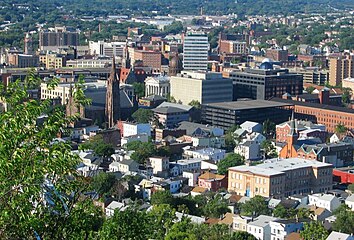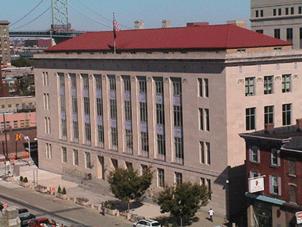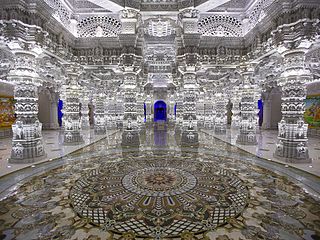Demographics

| Historical population | |||
|---|---|---|---|
| Census | Pop. | %± | |
| 1790 | 184,139 | — | |
| 1800 | 211,149 | 14.7% | |
| 1810 | 245,562 | 16.3% | |
| 1820 | 277,575 | 13.0% | |
| 1830 | 320,823 | 15.6% | |
| 1840 | 373,306 | 16.4% | |
| 1850 | 489,555 | 31.1% | |
| 1860 | 672,035 | 37.3% | |
| 1870 | 906,096 | 34.8% | |
| 1880 | 1,131,116 | 24.8% | |
| 1890 | 1,444,933 | 27.7% | |
| 1900 | 1,883,669 | 30.4% | |
| 1910 | 2,537,167 | 34.7% | |
| 1920 | 3,155,900 | 24.4% | |
| 1930 | 4,041,334 | 28.1% | |
| 1940 | 4,160,165 | 2.9% | |
| 1950 | 4,835,329 | 16.2% | |
| 1960 | 6,066,782 | 25.5% | |
| 1970 | 7,168,164 | 18.2% | |
| 1980 | 7,364,823 | 2.7% | |
| 1990 | 7,730,188 | 5.0% | |
| 2000 | 8,414,350 | 8.9% | |
| 2010 | 8,791,894 | 4.5% | |
| 2019 (est.) | 8,882,190 | 1.0% | |
| Source: 1910–2010 2019 Estimate | |||
State population
The United States Census Bureau estimates that the population of New Jersey was 8,882,190 on July 1, 2019, a 1.03% increase since the 2010 United States Census. Residents of New Jersey are most commonly referred to as "New Jerseyans" or, less commonly, as "New Jerseyites". As of the 2010 census, there were 8,791,894 people living in the state. The racial makeup of the state was:
- 68.6% White American
- 13.7% African American
- 8.3% Asian American
- 0.3% Native American
- 2.7% Multiracial American
- 6.4% other races
17.7% of the population were Hispanic or Latino (of any race).
| Racial composition | 1970 | 1990 | 2000 | 2010 |
|---|---|---|---|---|
| White | 88.6% | 79.3% | 72.5% | 68.6% |
| Black | 10.7% | 13.4% | 13.6% | 13.7% |
| Asian | 0.3% | 3.5% | 5.7% | 8.3% |
| Native | 0.1% | 0.2% | 0.2% | 0.3% |
| Native Hawaiian and other Pacific Islander |
– | – | – | – |
| Other race | 0.3% | 3.6% | 5.4% | 6.4% |
| Two or more races | – | – | 2.5% | 2.7% |
Non-Hispanic Whites were 58.9% of the population in 2011, down from 85% in 1970.
In 2010, unauthorized immigrants constituted an estimated 6.2% of the population. This was the fourth-highest percentage of any state in the country. There were an estimated 550,000 illegal immigrants in the state in 2010. Among the municipalities which are considered sanctuary cities are Camden, Jersey City and Newark.
As of 2010, New Jersey was the eleventh-most populous state in the United States, and the most densely populated, at 1,185 residents per square mile (458 per km2), with most of the population residing in the counties surrounding New York City, Philadelphia, and along the eastern Jersey Shore, while the extreme southern and northwestern counties are relatively less dense overall. It is also the second wealthiest state according to the U.S. Census Bureau.
The center of population for New Jersey is located in Middlesex County, in the town of Milltown, just east of the New Jersey Turnpike.
New Jersey is home to more scientists and engineers per square mile than anywhere else in the world.
On October 21, 2013, same-sex marriages commenced in New Jersey.
New Jersey is one of the most ethnically and religiously diverse states in the United States. As of 2011, 56.4% of New Jersey's children under the age of one belonged to racial or ethnic minority groups, meaning that they had at least one parent who was not non-Hispanic white. The state has the second largest Jewish population by percentage (after New York); the second largest Muslim population by percentage (after Michigan); the largest population of Peruvians in the United States; the largest population of Cubans outside of Florida; the third highest Asian population by percentage; and the second highest Italian population, according to the 2000 Census. African Americans, Hispanics (Puerto Ricans and Dominicans), West Indians, Arabs, and Brazilian and Portuguese Americans are also high in number. New Jersey has the third highest Asian Indian population of any state by absolute numbers and the highest by percentage, with Bergen County home to America's largest Malayali community. Overall, New Jersey has the third largest Korean population, with Bergen County home to the highest Korean concentration per capita of any U.S. county (6.9% in 2011). New Jersey also has the fourth largest Filipino population, and fourth largest Chinese population, per the 2010 U.S. Census. The five largest ethnic groups in 2000 were: Italian (17.9%), Irish (15.9%), African (13.6%), German (12.6%), Polish (6.9%).
India Square, in Bombay, Jersey City, Hudson County, is home to the highest concentration of Asian Indians in the Western Hemisphere. Meanwhile, Central New Jersey, particularly Edison and surrounding Middlesex County, is prominently known for its significant concentration of Asian Indians. The world's largest Hindu temple was inaugurated in Robbinsville in 2014, a BAPS temple. The growing Little India is a South Asian-focused commercial strip in Middlesex County, the U.S. county with the highest concentration of Asian Indians. The Oak Tree Road strip runs for about one-and-a-half miles through Edison and neighboring Iselin in Woodbridge Township, near the area's sprawling Chinatown and Koreatown, running along New Jersey Route 27. It is the largest and most diverse South Asian cultural hub in the United States. Carteret's Punjabi Sikh community, variously estimated at upwards of 3,000, is the largest concentration of Sikhs in the state. Monroe Township in Middlesex County has experienced a particularly rapid growth rate in its Indian American population, with an estimated 5,943 (13.6%) as of 2017, which was 23 times the 256 (0.9%) counted as of the 2000 Census; and Diwali is celebrated by the township as a Hindu holiday. In Middlesex County, election ballots are printed in English, Spanish, Gujarati, Hindi, and Punjabi.
Newark was the fourth poorest of U.S. cities with over 250,000 residents in 2008, but New Jersey as a whole had the second-highest median household income as of 2014. This is largely because so much of New Jersey consists of suburbs, most of them affluent, of New York City and Philadelphia. New Jersey is also the most densely populated state, and the only state that has had every one of its counties deemed "urban" as defined by the Census Bureau's Combined Statistical Area.
In 2010, 6.2% of its population was reported as under age 5, 23.5% under 18, and 13.5% were 65 or older; and females made up approximately 51.3% of the population.
A study by the Pew Research Center found that in 2013, New Jersey was the only U.S. state in which immigrants born in India constituted the largest foreign-born nationality, representing roughly 10% of all foreign-born residents in the state.
For further information on various ethnoracial groups and neighborhoods prominently featured within New Jersey, see the following articles:
- Hispanics and Latinos in New Jersey
- Indians in the New York City metropolitan region
- Chinese in the New York City metropolitan region
- List of U.S. cities with significant Korean American populations
- Filipinos in the New York City metropolitan region
- Filipinos in New Jersey
- Russians in the New York City metropolitan region
- Bergen County
- Jersey City
- India Square in Jersey City, home to the highest concentration of Asian Indians in the Western Hemisphere
- Ironbound, a Portuguese and Brazilian enclave in Newark
- Five Corners, a Filipino enclave in Jersey City
- Havana on the Hudson, a Cuban enclave in Hudson County
- Koreatown, Fort Lee, a Korean enclave in southeast Bergen County
- Koreatown, Palisades Park, also a Korean enclave in southeast Bergen County
- Little Bangladesh, a Bangladeshi enclave in Paterson
- Little India (Edison/Iselin), the largest and most diverse South Asian hub in the United States
- Little Istanbul, also known as Little Ramallah, a Middle Eastern enclave in Paterson
- Little Lima, a Peruvian enclave in Paterson
Birth data
As of 2011, 56.4% of New Jersey's population younger than age 1 were minorities (meaning that they had at least one parent who was not non-Hispanic white).
Note: Births in table do not add up, because Hispanics are counted both by their ethnicity and by their race, giving a higher overall number.
| Race | 2014 | 2015 | 2016 | 2017 | 2018 |
|---|---|---|---|---|---|
| White: | 71,033 (68.8%) | 72,400 (70.2%) | ... | ... | ... |
| > Non-Hispanic White | 48,196 (46.6%) | 47,425 (46.0%) | 46,076 (44.9%) | 45,825 (45.3%) | 45,500 (44.9%) |
| Black | 20,102 (19.4%) | 18,363 (17.8%) | 13,870 (13.5%) | 13,684 (13.5%) | 13,886 (13.7%) |
| Asian | 11,977 (11.6%) | 12,192 (11.8%) | 12,053 (11.7%) | 11,691 (11.5%) | 11,452 (11.3%) |
| American Indian | 193 (0.2%) | 172 (0.2%) | 62 (0.0%) | 72 (0.1%) | 67 (0.1%) |
| Hispanic (of any race) | 27,267 (26.4%) | 27,919 (27.1%) | 28,083 (27.3%) | 27,354 (27.0%) | 27,597 (27.3%) |
| Total New Jersey | 103,305 (100%) | 103,127 (100%) | 102,647 (100%) | 101,250 (100%) | 101,223 (100%) |
- Since 2016, data for births of White Hispanic origin are not collected, but included in one Hispanic group; persons of Hispanic origin may be of any race.
Languages
| Language | Percentage of population (as of 2010) |
|---|---|
| Spanish | 14.59% |
| Chinese (including Cantonese and Mandarin) | 1.23% |
| Italian | 1.06% |
| Portuguese | 1.06% |
| Filipino | 0.96% |
| Korean | 0.89% |
| Gujarati | 0.83% |
| Polish | 0.79% |
| Hindi | 0.71% |
| Arabic | 0.62% |
| Russian | 0.56% |
As of 2010, 71.31% (5,830,812) of New Jersey residents age 5 and older spoke English at home as a primary language, while 14.59% (1,193,261) spoke Spanish, 1.23% (100,217) Chinese (which includes Cantonese and Mandarin), 1.06% (86,849) Italian, 1.06% (86,486) Portuguese, 0.96% (78,627) Tagalog, and Korean was spoken as a main language by 0.89% (73,057) of the population over the age of five. In total, 28.69% (2,345,644) of New Jersey's population age 5 and older spoke a mother language other than English.
A diverse collection of languages has since evolved amongst the state's population, given that New Jersey has become cosmopolitan and is home to ethnic enclaves of non-English-speaking communities:
High-rise residential complexes in the borough of Fort Lee

Paterson, known as the "Silk City", has become a prime destination for an internationally diverse pool of immigrants, with at least 52 distinct ethnic groups.

Skyscrapers in Jersey City, one of the most ethnically diverse cities in the world

Federal Courthouse in Camden, which is connected to Philadelphia via the Benjamin Franklin Bridge in the background
Religion
By number of adherents, the largest denominations in New Jersey, according to the Association of Religion Data Archives in 2010, were the Roman Catholic Church with 3,235,290; Islam with 160,666; and the United Methodist Church with 138,052. The world's largest Hindu temple was inaugurated in Robbinsville, Mercer County, in central New Jersey during 2014, a BAPS temple. In January 2018, Gurbir Grewal became the first Sikh American state attorney general in the United States. In January 2019, Sadaf Jaffer became the first female Muslim American mayor, first female South Asian mayor, and first female Pakistani-American mayor in the United States, of Montgomery in Somerset County.

Cathedral Basilica of the Sacred Heart in Newark, the fifth-largest cathedral in North America, is the seat of the city's Roman Catholic Archdiocese.
Temple Sharey Tefilo-Israel, in South Orange, Essex County. New Jersey is home to the second-highest Jewish American population per capita, after New York.

Swaminarayan Akshardham (Devnagari) in Robbinsville, Mercer County, inaugurated in 2014 as the world's largest Hindu temple
Settlements
- Bergen County: 936,692
- Middlesex County: 829,685
- Essex County: 799,767
- Hudson County: 676,061
- Monmouth County: 621,354
- Ocean County: 601,651
- Union County: 558,067
- Camden County: 507,078
- Passaic County: 503,310
- Morris County: 494,228
- Burlington County: 445,384
- Mercer County: 369,811
- Somerset County: 331,164
- Gloucester County: 291,408
- Atlantic County: 265,429
- Cumberland County: 150,972
- Sussex County: 140,799
- Hunterdon County: 124,714
- Warren County: 105,779
- Cape May County: 92,560
- Salem County: 62,607
For its overall population and nation-leading population density, New Jersey has a relative paucity of classic large cities. This paradox is most pronounced in Bergen County, New Jersey's most populous county, whose more than 930,000 residents in 2019 inhabited 70 municipalities, the most populous being Hackensack, with 44,522 residents estimated in 2018. Many urban areas extend far beyond the limits of a single large city, as New Jersey cities (and indeed municipalities in general) tend to be geographically small; three of the four largest cities in New Jersey by population have under 20 square miles (52 km2) of land area, and eight of the top ten, including all of the top five have land area under 30 square miles (78 km2). As of the 2010 United States Censusupdate, only four municipalities had populations in excess of 100,000, although Edison and Woodbridge came very close.
| Rank | Name | Area (sq.mi.) | Area (km2) | County |
|---|---|---|---|---|
| 1 | Galloway Township | 115.2 | 298 | Atlantic County |
| 2 | Hamilton Township | 113.0 | 293 | Atlantic County |
| 3 | Washington Township | 102.9 | 267 | Burlington County |
| 4 | Jackson Township | 100.1 | 259 | Ocean County |
| 5 | Lacey Township | 98.5 | 255 | Ocean County |
| 6 | Woodland Township | 96.4 | 250 | Burlington County |
| 7 | Maurice River Township | 95.7 | 248 | Cumberland County |
| 8 | Middle Township | 83.1 | 215 | Cape May County |
| 9 | Manchester Township | 82.9 | 215 | Ocean County |
| 10 | West Milford | 80.4 | 208 | Passaic County |
| 11 | Bass River Township | 78.2 | 203 | Burlington County |
| 12 | Egg Harbor Township | 75.0 | 194 | Atlantic County |
| 13 | Little Egg Harbor Township | 73.2 | 190 | Ocean County |
| 14 | Lower Alloways Creek Township | 72.6 | 188 | Salem County |
| 15 | Vernon Township | 70.5 | 183 | Sussex County |
| 16 | Upper Township | 68.5 | 177 | Cape May County |
| 17 | Wantage Township | 67.5 | 175 | Sussex County |
| 18 | Dennis Township | 64.3 | 167 | Cape May County |
| 19 | Pemberton Township | 62.5 | 162 | Burlington County |
| 20 | Howell Township | 61.0 | 158 | Monmouth County |
| 21 | Middletown Township | 59.3 | 154 | Monmouth County |
| 22 | Hopewell Township | 58.7 | 152 | Mercer County |
| 23 | Winslow Township | 58.1 | 150 | Camden County |
| 24 | Mullica Township | 56.9 | 147 | Atlantic County |
| 25 | Berkeley Township | 55.8 | 145 | Ocean County |
| 26 | Hillsborough Township | 54.8 | 142 | Somerset County |
| 26 | Stafford Township | 54.8 | 142 | Ocean County |
Largest cities or towns in New Jersey
Source: | |||||||||
|---|---|---|---|---|---|---|---|---|---|
| Rank | Name | County | Pop. | ||||||
 Newark  Jersey City |
1 | Newark | Essex | 282,090 |  Paterson  Elizabeth | ||||
| 2 | Jersey City | Hudson | 265,549 | ||||||
| 3 | Paterson | Passaic | 145,627 | ||||||
| 4 | Elizabeth | Union | 128,885 | ||||||
| 5 | Lakewood Township | Ocean | 104,157 | ||||||
| 6 | Edison | Middlesex | 100,693 | ||||||
| 7 | Woodbridge Township | Middlesex | 100,450 | ||||||
| 8 | Toms River | Ocean | 93,717 | ||||||
| 9 | Hamilton Township (Mercer) | Mercer | 87,552 | ||||||
| 10 | Clifton | Passaic | 85,273 | ||||||







Comments
Post a Comment